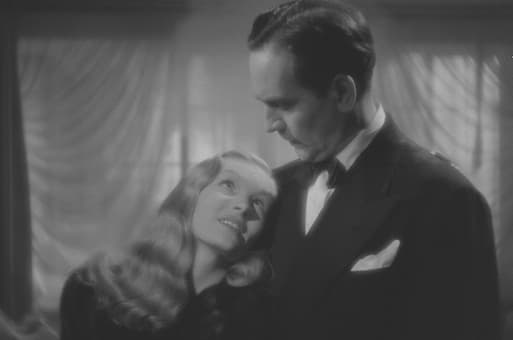
* * *
For the better part of January, the Museum of Modern Art will be patting itself on the back for its efforts in film preservation, and of course it deserves to do so. Since 2003, the museum has mounted To Save and Project, an annual festival that highlights restorations of films from its collection, as well as those from partner institutions. The selections in past years have proved eclectic: silent shorts, B-movies, avant-gardist experiments, documentaries, films from the world over, you name it.
The 2023 version, which begins January 12 and runs through February 2, promises even more. The films opening and closing the series are silent: “The Cat and the Canary” (1927) and “The Marriage Circle” (1924). The latter was directed by Ernst Lubitsch, a name that has a certain cachet, particularly for those who enjoy their comedy on the sophisticated side. Paul Leni, director of “The Cat and the Canary,” might be a harder sell to the general public. His oeuvre is limited — he died of sepsis at age 44 — and his vision more esoteric.
Still, popular culture is unimaginable without the precedent set by Leni. Working from a play of the same name by John Willard, he amplified the old dark house mise en scène of “The Cat and the Canary” by draping it within the cinematic mannerisms of German Expressionism: dramatic lighting, steep angles, sweeping movements, and an abiding sense of psychological interiority. Somewhat counterintuitively, Leni also had a way with humor, managing to underline the story’s spooky ambiance and proto-jump scares with comedic devices that are employed to this day.
“The Marriage Circle” was the second film the German-born Lubitsch made after coming to the United States. Having been wooed to these shores by Mary Pickford, Lubitsch directed her in “Rosita” (1923), an experience that left both its star and director drained and disappointed. In adapting Lothar Schmidt’s play “Only a Dream,” Lubitsch went small, crafting a romantic farce with only five characters. Those who avoid silent films on principle will groan over the pasty-faced male leads, but they should also take note of how cannily Lubitsch suggests sound as well as erotic longing. That, and “The Marriage Circle” is pretty funny.
During René Clair’s lifetime, the director of “I Married a Witch,” also included in the To Save and Project festival, was considered among the greatest of filmmakers, but, boy, how his star has fallen. The French New Wave had a hand in his denigration — “Clair,” François Truffaut wrote, “makes films for old ladies who go to the cinema twice a year” — and the director doesn’t even rate a mention in the recent (and much beleaguered) Sight and Sound magazine list of 100-greatest films.
There are, however, few filmmakers who are as nuanced and gentle in their skepticism about the human condition. Sometimes old ladies know a thing or two.
It’s a wonder “I Married a Witch” is as good as it is. Clair, having finished his first American film, “The Flame of New Orleans,” to little fanfare and disappointing box office, brought a story titled “The Passionate Witch” to director and writer Preston Sturges, then a prime operator at Paramount Studios. Sturges convinced Clair that the property would be perfect for Veronica Lake, but subsequently fell out with the Frenchman. In the end, Sturges demanded that his name be removed from the project.
The script went through convulsions as well, with writers coming and going. Then, Fredric March wasn’t fond of his co-star, having dismissed Lake as “a brainless little blonde sexpot, void of any acting ability.” The immaculately coiffed actress did have a reputation for being difficult, but hadn’t March seen “Sullivan’s Travels”? She was impressive and whiplash smart in her delivery. Sexy, yes; brainless, definitely not.
Here, Lake is magnificent as Jennifer Wooley, a witch who ends up complicating the life of gubernatorial candidate Wallace Wooley (March). Hand it to two old pros for papering over their rancor: The chemistry — and heat — generated by March and Lake is not only convincing but utterly winning. “I Married a Witch” isn’t quite on a level with the masterworks of Clair’s French periods, pictures like “Le Million” and “À Nous la Liberté” (both 1931) or the later “Les Grandes Manœuvres” (1955), but it is a sparkling entertainment all the same.
Should screwball comedy not be your forte, there are other worthy films at MoMA worth your time, whether it be “The Unknown” (1927), in which Lon Chaney Jr. goes to extreme measures to win the love of a young Joan Crawford, or director Yasujiro Ozu navigating the perils of fidelity in “A Hen in the Wind” (1948). The latter is typically fobbed off as minor Ozu — the director considered it his worst movie— but it contains scenes of such unassailable tenderness that its relative drawbacks are easily forgiven.
Also of interest is “Reform School” (1939), a “race” movie that features the indomitable Louise Beavers in a role removed from the domestic roles she was typically saddled with. Indeed, Beavers is quite the fashion plate here as Mother Barton, a probationary officer tasked with reforming the “Harlem Tuff Kids,” the uptown equivalent of the Bowery Boys. Long considered lost, the picture’s restoration and airing during the run of To Save and Project will likely encourage further deep dives into the history of American film.
(c) 2023 Mario Naves
This article was originally published in the January 5, 2023 edition of The New York Sun.